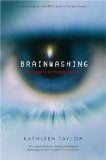 Brainwashing: The Science of Thought Control
Brainwashing: The Science of Thought Control
by Kathleen Taylor
Oxford University Press, £18.99, ISBN 0-19-280496-0
This is a book of three parts. In the first section, Taylor outlines the history and social psychology of brainwashing, presenting a clear description of research into cults, charismatic leaders, military mind control, and the like. So far, so good. Part two then attempts to understand brainwashing within the context of recent advances in neuroscience. Taylor presents a clear description of neurons, membranes and the like, and then attempts to explain how neuroscience may help to explain brainwashing.
Unfortunately, many of the arguments are far from convincing. Although it is obvious that dramatic alterations in self identity and episodic memory will be associated with changes in the cortex, it is not clear that this is the best level to understand brainwashing. For example, Taylor spends time examining vision, tracking this complex process from eye movements to the processing of visual information in a part of the brain known as the posterior parietal cortex. However, it is unclear how this helps us to understand why some people join new religious movements or the effects that such groups have on their behaviours.
In the final part, the author considers the implications of viewing brainwashing from a neuroscience perspective. Much of this section builds towards what the author refers to as FACET – that is, the need for Freedom, Agency, Complexity, Ends-not-means and Thinking. It is a rather confusing end message that fails to provide a strong sense of closure. In short, although this book does provide some interesting information about brainwashing, I suspect that the general thrust of the argument (i.e., that the phenomena can be understood from a neuro-science perspective) will fail to have a significant impact.
Richard Wiseman

